Kom Ombo
Kom Ombo is a unique double temple. Two sets of courts, halls, sanctuaries and rooms are on each side of a main axis. The gods worshiped in the northern section were Haroeris, Tasenetnofret and Panebtawy. The gods of the southern section were Sobek, Hathor and Khonsu. Egyptologists have restored this temple. Egyptologists found several hundred crocodile mummies (Sobek’s animal symbol) near the temple site.
iS ONE of the more unusual temples in Egypt. Due to the conflict between Sobek and Horus, the ancient Egyptians felt it necessary to separate their temple spaces within one temple. The Kom Ombo temple has two entrances, two courts, two colonnades, two Hypostyle halls and two sanctuaries, one side for each god.
Kom Ombo History
The Kom Ombo Temple was built between 332 BC and 395 AD, during the Ptolemaic period, by Ptolemy VI Philometer. Ptolemy XII Neos Dionysos continued the work and built the exterior and interior Hypostyle halls. The temple was built with local limestone by men who rode on elephants, considered to be a Ptolemaic innovation.
Little remains of the original structure. Unfortunately, a good portion of the temple has been destroyed over the millennia by earthquakes, erosion by the Nile River and builders who stole stone for unrelated projects. In 1893, a French archaeologist by the name of Jacques de Morgan cleared the Southern portion (the half dedicated to Sobek) of debris and restored it.
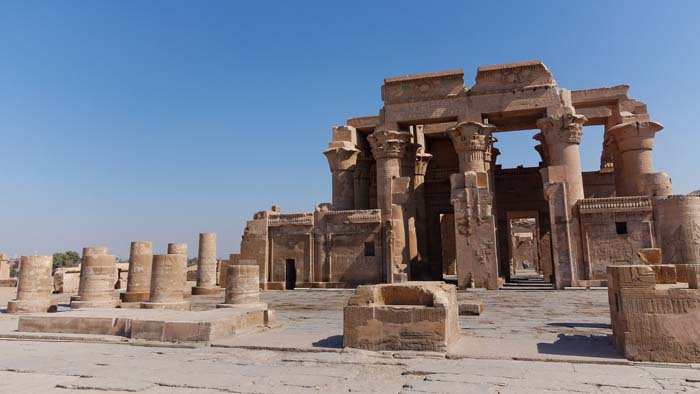
© NeferTiyi - The Kom Ombo Temple
During the Roman period, additions to the temple were made in the form of decorations in the main court. At this time, an outer corridor was also added. Augustus built an outer enclosure wall and a portion of the court, but those structures have since been lost. The Coptic Church took over the temple and converted it into their own place of worship. It was at this time that many of the ancient reliefs were defaced and removed.
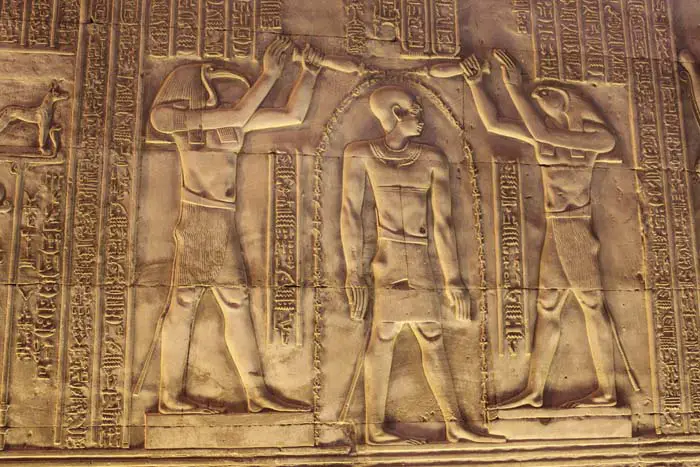
© Georg Wittberger - Relief at Kom Ombo
Kom Ombo Temple Dedications
Kom Ombo was dedicated mainly to Sobek and Horus; however, some of their family members were part of the temple’s dedication as well. The Southern portion of the temple was not just dedicated to Sobek, the god of fertility, but also to Hathor, the goddess of love and joy, and Khonsu, the god of the moon. In this portion of the temple there are many crocodile representations to pay homage to Sobek. This part of the temple is also called “House of the Crocodile.”
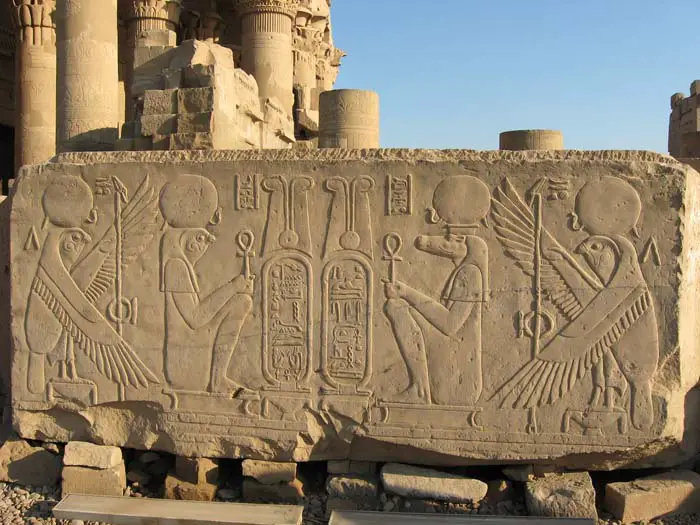
© Gerik Zayatz - Depiction of Horus and Sobek
The Northern portion of the temple was dedicated mainly to Horus, god of the sun, and also Tasenetnofret, meaning “the good sister,” and a manifestation of Hathor, and Panebtaway, meaning “the Lord of two lands” which represented Egyptian kingship. In this part of the temple, there are many representations of falcons to pay homage to the falcon-headed god, Horus. This part of the temple is also called “Castle of the Falcon.”
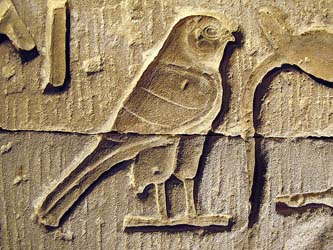
© Mindy McAdams - Relief of Horus
Kom Ombo Temple Layout
Just after crossing the gate inside the temple, there is a small room dedicated to Hathor. Today, it is used to display the many mummified crocodiles that were found in the temple’s vicinity. A well in front of the main entrance was once used as a Nilometer. The first pylon, which has since been destroyed, now consists only of foundation stones and a portion of a wall.
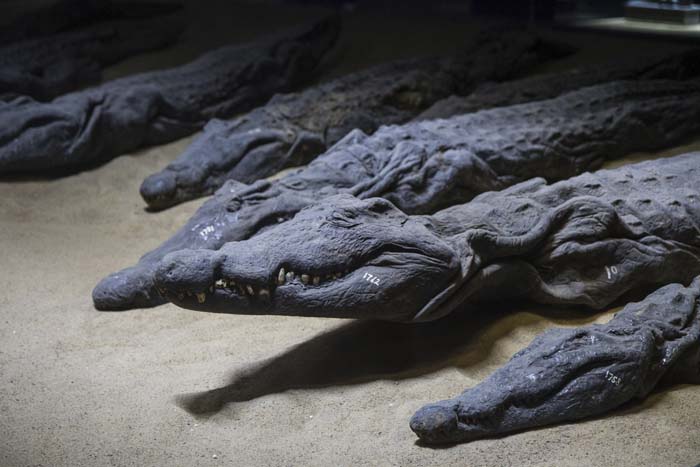
© Garrett Ziegler - Mummified Crocodiles at Kom Ombo
Entering into the main court, there are 16 painted columns, eight on each side of the court. A granite altar sits in the center of the main court, likely where the sacred boat was placed. On the rear wall of the main court are five lotus-shaped columns along with a screen wall. Two entrances, one for each deity, open up here. Through both entrances lies the first Hypostyle hall. There are ten lotus-shaped columns here with the middle two separating the two halves of the hall.
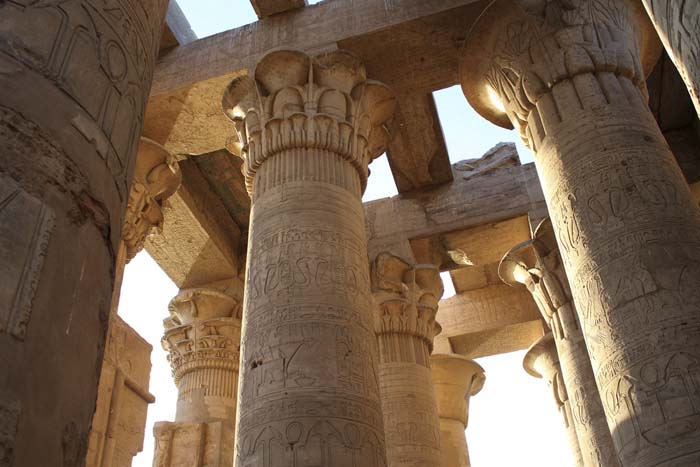
© Georg Wittberger - Columns at Kom Ombo
Separate entrances guide visitors into the second Hypostyle hall known as “The Hall of Offering”. Beyond this Hall of Offering are three antechambers, now all nearly destroyed. Curiously, the twin sanctuaries which are found beyond the antechambers are separated by a hidden chamber. A dual passageway runs the perimeter of the entire temple and there are seven additional rooms along the interior passage. A staircase leads to the roof.
Kom Ombo Quick Facts
- Along with the God of Victory, Ancient Egyptians believed Horus was also a doctor. The Kom Ombo temple was known for its healing powers and people made pilgrimages to Kom Ombo to be healed.
- On the back wall of the temple exists the very first known representations of precise surgical tools. Some of these tools include suction caps, scalpels, bone saws, dental tools, medicine bottles, forceps, birthing chairs and forceps.
- A huge number of crocodiles once roamed the area inside and around the Kom Ombo temple.
- More than 300 crocodile mummies were found at the Kom Ombo temple and now reside in the nearby Crocodile Museum.
- The hidden chamber between the two sanctuaries was used for priests to act as the “Oracle” pronouncing god’s will.
- The ceiling in the first Hypostyle hall is decorated with astronomical scenes including scenes of Nut, goddess of the sky and the universe.
- Many columns in the temple boast reliefs of the pharaoh paying homage to many different gods.
- The temple is oriented East to West, based on "local" North which was determine by the Nile River.
- In the Horus myth, the allies of Seth made their escape by changing into crocodiles.
Dendera
The temple complex at Dendera covers 40,000 square meters. Composed of several buildings from different periods, it is one of the best preserved sites of ancient Egypt. The main structure is the temple dedicated to Hathor, the goddess of love and motherhood. Notable findings in the complex are the Dendera Zodiac, the necropolis, the Dendera Light and the colorful paintings on the ceiling of the temple.
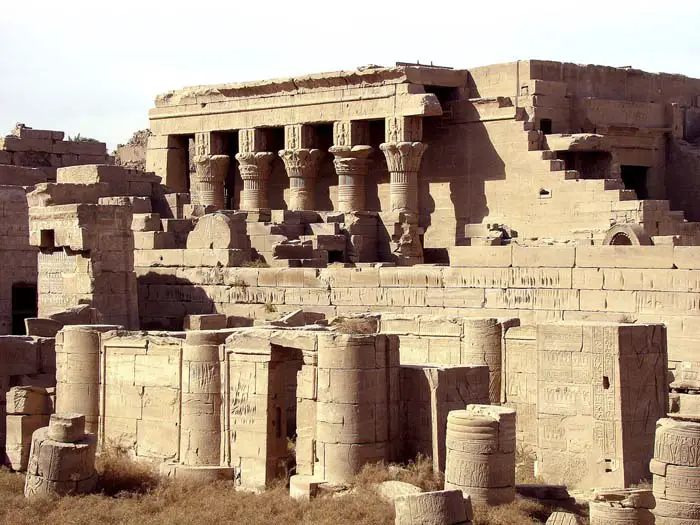
© Richard White - Dendera Temple
Sacred Space
The sacred space is an area set aside for the worship of a deity. People constructed a temple or shrine to the god on the space to worship the deity. They chose a sacred space because of its location or because a deity sent a sign that the area was special. After the priests chose a space, they conducted rituals to purify the space and built a religious structure.
Priests used these spaces for centuries and constructed new buildings over older buildings. Excavating religious sites can be difficult because a temple structure is often on the surface. Digging down to see the lower level is challenging due to the extant building. The excavation has the potential to damage the temple on the surface.
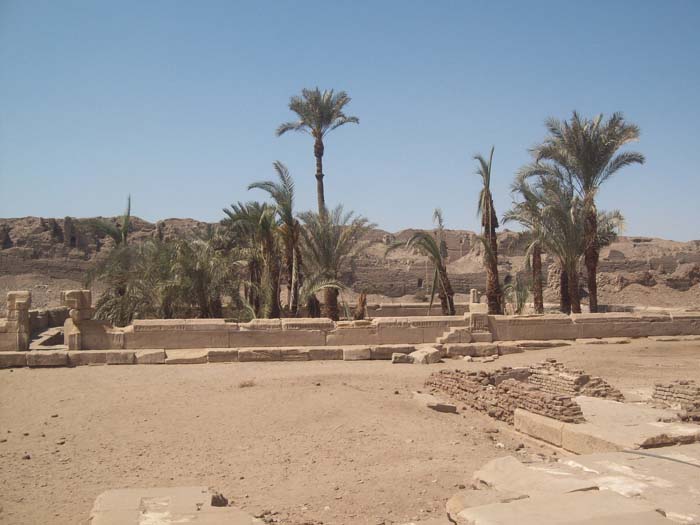
© isawnyu - The Sacred Lake at Dendera Temple
Public Temples
Through the years, temples served a variety of purposes. The primary purpose of most temples in ancient Egypt was to house and care for the gods to which they were dedicated. It seemed the very existence and good fortune of the entire land of Egypt rested upon tending to the gods. The worst fate that could befall a city was failing to care for the temple of the patron god. A god who lacked attention would become angry and flee the temple, leaving the citizens of that town open to all kinds of disasters.
Beyond serving the needs of the gods, some temples also served other purposes. No king could rule the Egyptian nation without first becoming a god. In an elaborate ceremony, the new pharaohwould enter the temple, along with the high priests. Once inside the most exclusive chambers of the temple, they would perform rituals meant to transform the mere mortal pharaoh into a deity. The king would then be revered and worshiped by the Egyptian people, some temples having been reserved for the worship of the pharaoh.
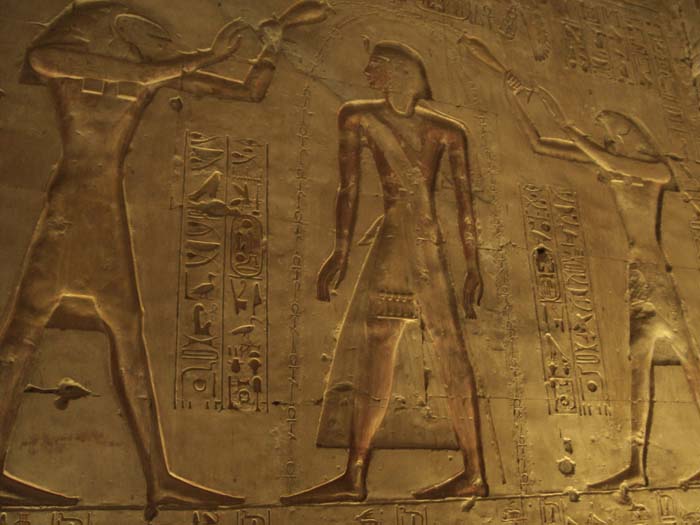
© isawnyu - Relief depicting two gods 'purifying' Seti I
Structure and appearance
The temple structure had three meanings for the ancient Egyptians. First, it was the mansion where a god lived. Second, it represented the primeval island the god stood on to create the universe. For this reason, the inner sanctuary, the location of the god’s statue, was higher than the rest of the temple. Third, the people saw the temple as a miniature representation of the universe and the heavens.
Due to the lack of wood, in ancient Egypt temples were constructed of stone. The only other building material that was readily available was mud brick, which was known to crumble after just a few years. The temples built to house the gods were required to last for eternity and, therefore, stone was the only other viable choice.
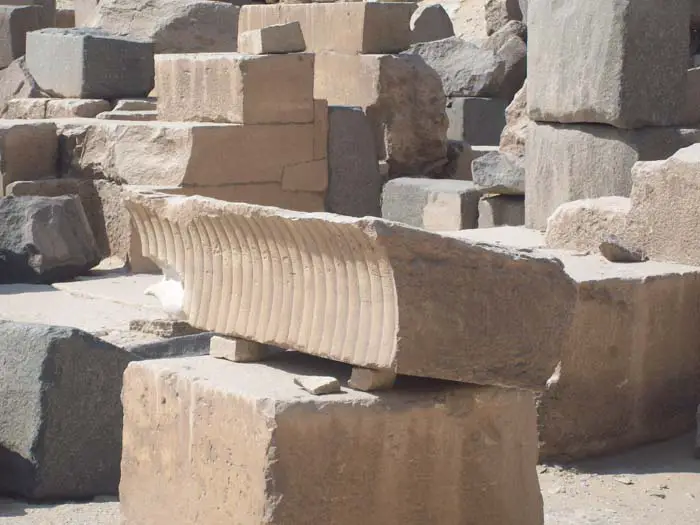
© isawnyu - Stone blocks from the mortuary temple of Sahure
Wall reliefs covered most of the temple walls and included images and inscriptions. The Hypostyle hall often contained scenes and inscriptions of a historical nature. These reliefs detailed events from a pharaoh’s reign or important temple events. Other carved reliefs showed rituals conducted in specific rooms. Many of these showed the pharaoh conducting the ritual. The reliefs also had images of the gods and some of the myths about the gods.
Temple Features
Inside ancient Egyptian temples, there was a segregated system of sanctuaries, divided by the spiritual level of the people allowed to enter them. Those who had not yet reached spiritual worthiness were not allowed to enter the innermost chambers. Some Egyptian temples also had an exterior complex comprised of gardens and courtyards.
- Obelisk - carved monuments that pharaohs put up near pylon entrances.
- Pylon - giant gateway that provided entrance to a temple with carved images of the pharaoh.
- Inner Sanctuary - the place where priests placed the god’s statue. It contained a box where priests kept the statue at night. An altar was near the box and priests put the statue on the altar every day and presented it with offerings.
- Barque Chamber - the storeroom for the miniature boat that carried the god’s statue.
- Storerooms - the places for goods used in rituals.
- Courtyard - the area where people placed statues and votive offerings dedicated to the god.
- Statues - images of the gods or pharaohs.
- Votive Offerings - amulets, steles or statues dedicated by people to the gods. These could include a prayer for help or thanksgiving. Sometimes priests removed these items from the courtyard and buried them. One of these caches at the temple of Karnak contained over 17,000 items.
- Hypostyle Hall - covered hall filled with carved columns. Most of the columns had carved tops that resembled plants.
- Sacred Pool - a pool of water where priests bathed to ensure their ritual purity.
- Processional Way - used during festivals when priests carried the god’s statue in a barque. They were often lined with sphinx statues which the Egyptians considered guardians.
- Barque Shrines - way points along the processional way where the barque stopped.
- Workshops - places where people manufactured ritual objects and temple furniture.
- Enclosure Wall - wall built around the temple precinct to separate it from the city and limit access to the precinct.
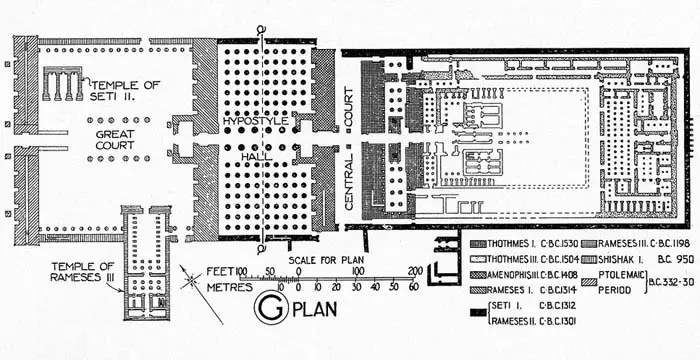
© psulibscollections - Temple of Amon -- Plan
Household Shrines
Household shrines where places in a private home that had offering tables. Individuals worshiped state gods like Amun-Ra in their homes. Two of the gods worshiped in homes were Bes and Tauret. Bes was the protector of young children and he assisted with childbirth. Tauret was the goddess of childbirth and fertility. People left votive offerings at their household shrine. These included stelescarved with requests for help or thanksgiving.
Temple Employees
Priests
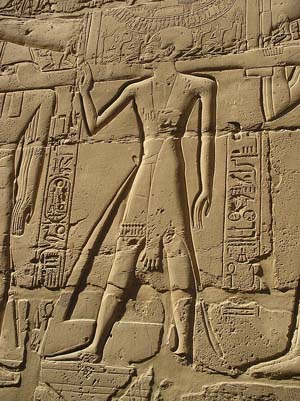
© Kenzyb - Karnak temple, priest relief
There were two types of priests in Ancient Egypt; full-time and lay priests. Full-time priests served the gods at all times. Lay priests served for three months a year, serving one month and then taking three months off before serving again. During the off times, lay priests had other jobs such as doctors or scribes. The High Priest oversaw all activities of the temple. Waab priests performed rituals and had to maintain ritual purity.
Priests attained their positions in several ways. The first way was for a man to inherit his position from his father. Another way was through an appointment by the pharaoh. A man could also buy a position in the priesthood. Priests voted to appoint a priest to a higher position.
A priest had to do several things after attaining his position. First a priest was circumcised, if he was not already. A serving priest had to be celibate and lived in the temple precinct. Priests were not permitted to wear any items made of animal products. Their clothes were made of linen and their shoes were also made of plant fibers.
Overtime, the priesthood of Amun achieved great political power. After the New Kingdom period, the High Priest of Amun had the power to give or withhold the god’s favor on the crown prince. Women held the position of God’s Wife of Amun and also had political power. They had to remain celibate at all times and adopted their heirs from the royal family. These women conducted some of the religious rituals.
Other Employees
- Craftsmen - made the votive offerings, statues, jewelry, clothing and ritual objects for the temple.
- Cleaners - kept the temple and its grounds tidy.
- Farmers - raised the food used in temple rituals.
- Slaves - usually foreign prisoners-of-war who worked in the temples.
Rituals
Through most of the ancient Egyptian history, there was a polytheistic religion where individuals were free to worship any god or goddess they chose. In most cases, multiple deities were worshiped. Some gods and goddesses enjoyed fame throughout Egypt, while others were limited to worship in select cities and villages. Each town had a patron god and a temple dedicated to that deity. An order of high priests oversaw the temple, the rites and the daily activities associated with the temples.
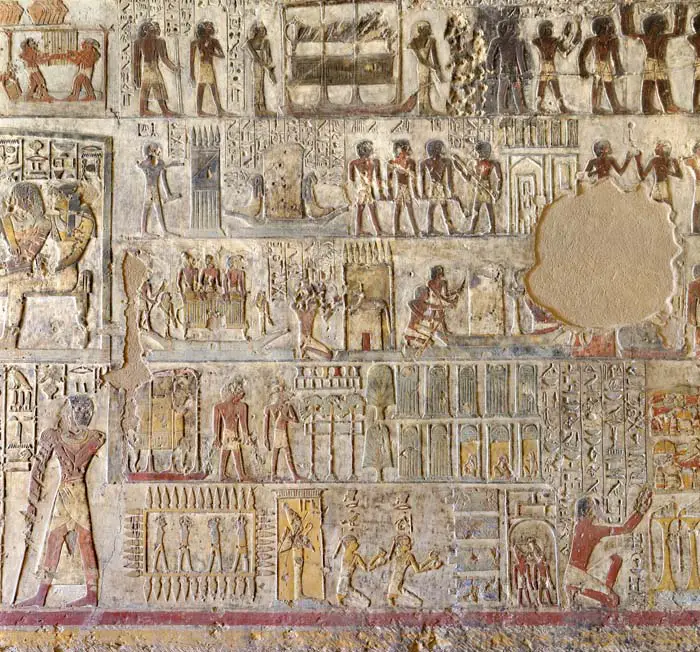
© kairoinfo4u - Depictions of rituals at the Tomb of Paheri
Rituals conducted at ancient Egyptian Temples served several purposes. First, they provided the gods with basic items like food and clothing. Rituals also ensured the god’s help in battle and the land’s fertility. Egyptian rituals hinged on the idea that providing goods for the gods ensured their protection and help. Festivals were rituals that took all the people could celebrate. During some of Amun’s festivals, people could ask the god questions. The priests would move the barque to show the god’s answer.
Daily Rituals
The priests and, sometimes, the pharaoh performed certain rituals daily. Pharaoh made offerings at some of the major temples. Priests who performed the daily rituals had to bathe in a sacred poolseveral times a day. The priest entered the Inner Sanctuary in the morning and removed the statue from its box.
Then, he washed the statue and dressed it in new clothing. The priest put fresh makeup on the statue and set it on the altar. He presented three meals a day to the statue while it set on the altar. After the statue ate, the priest took the food and distributed it to the priests.
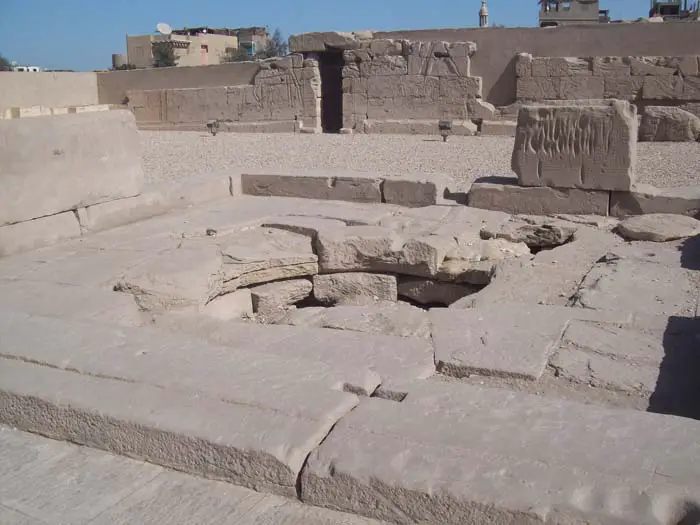
© isawnyu - Abydos -- Absolution well - used for the purification of priests
Festivals
Dozens of festivals took place throughout Egypt every year. These were times when the people could see the god’s statue as the priests carried its barque. One festival, the Beautiful Feast of the Valley, took place in the city of Thebes. During this festival, the Statue of Amun traveled from the Temple of Karnak to the western bank of the Nile. On the western bank, Amun visited the mortuary temples of previous pharaohs. Festivals helped ensure the Nile’s flooding and promoted the land’s fertility.
Temple Building Rituals
Priests conducted some rituals at different stages of a temple’s construction. The first ritual took place when the priests marked off the sacred space for the temple enclosure. The next ritual happened when the priests measured the dimensions of the temple building. Priests placed foundation deposits under the stones of the temple's foundations. After the temple's completion, the priests consecrated and named the building.
No comments:
Post a Comment